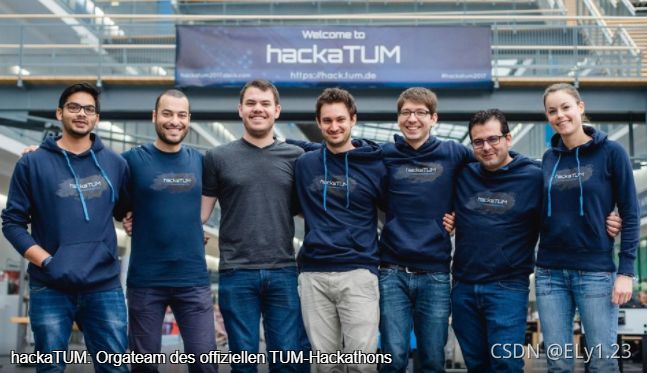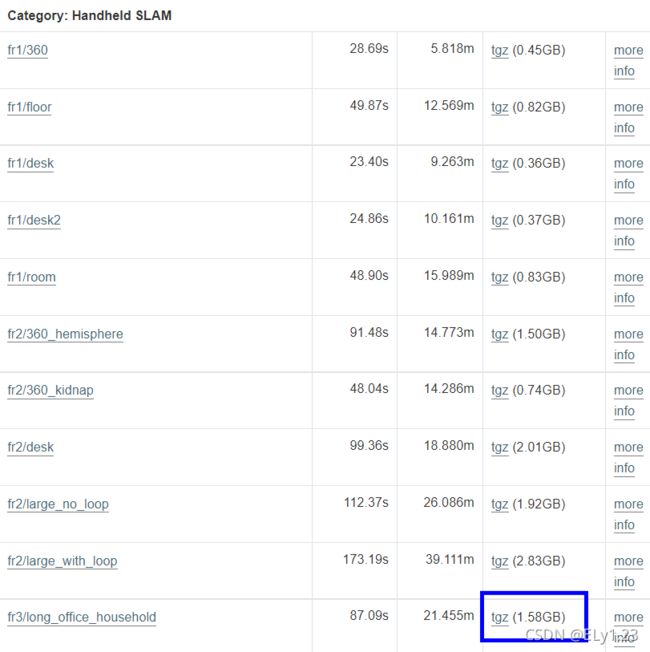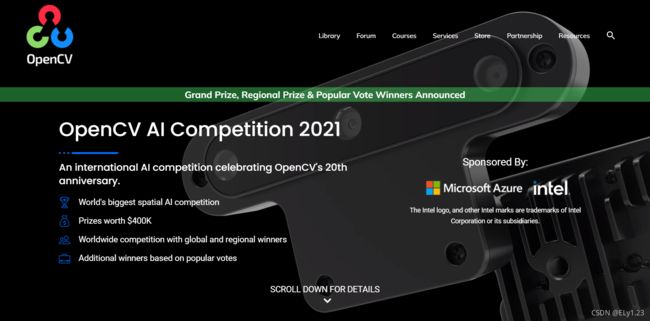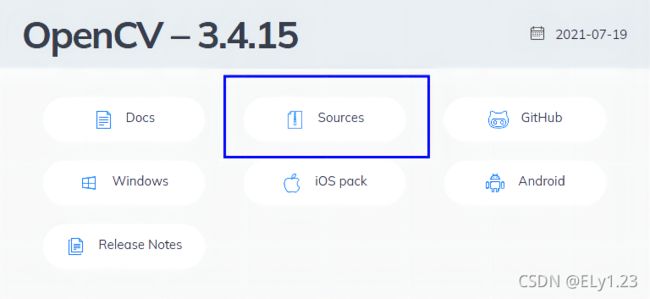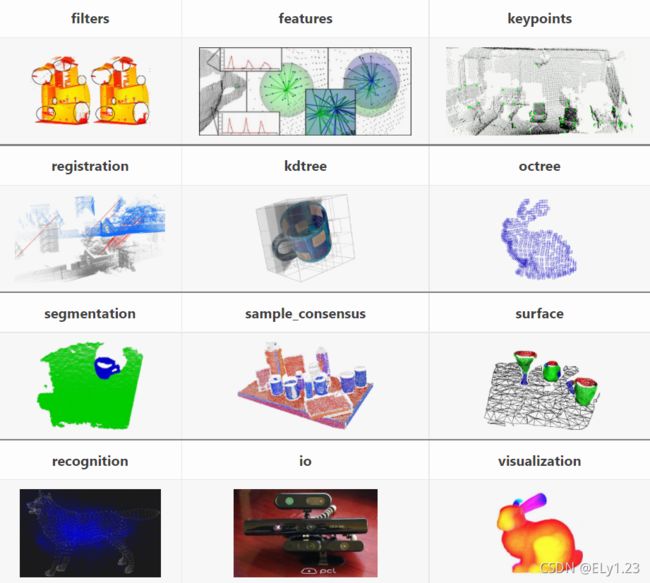一小时让你成为点云建图小将(固定帧数法选取关键帧)
创作时间:2021年11月1日
文章目录
- 摘要
- 建图原理
- RGBD相机
-
- 1. 简介
- 2. 特点
- TUM数据集
-
- 1. 简介
- 2. 特点
- 3. 下载
- 4. *教程
- 开源库
-
- 1. OpenCV
-
- 1.1. 简介
- 1.2. 特点
- 1.3. 安装
- 1.4. *教程
- 2. Eigen
-
- 2.1. 简介
- 2.2. 特点
- 2.3. 安装
- 2.4. *教程
- 3. PCL
-
- 3.1. 简介
- 3.2. 特点
- 3.3. 安装
- 3.4. *教程
- 建图实战
-
- 1. 说明
- 2. 建图框架
- 3. *框架分析
-
- 3.1. 下载数据集
- 3.2. 数据集预处理
- 3.3. 计算点云并拼接
- 3.4. 展示视频及点云
- 3.5. 最后的处理
- 4. 基于固定帧数选取法和窗口压缩法的建图总代码
- 5. 建图效果
- 现在与未来
- 参考文献
摘要
-
当今科技发展速度飞快,无论是无人驾驶,还是虚拟现实,诸多领域都需要进行建图,并在此基础上进行开发处理。地图主要分为稀疏地图、稠密地图和语义地图,它们有着不同的优缺点以及应用,其中稠密地图占据着一个非常重要的位置,它能应用于导航、避障、交互等工作。
-
本文围绕着稠密点云建图这个话题展开,在Ubuntu-18.04的操作系统下利用TUM数据集进行RGBD稠密建图。文章首先简单地说明了稠密建图的原理,然后简述了RGBD相机,接着概述了TUM数据集,讲解了它的一些特点以及如何下载和使用数据集。接着,文章介绍了建图所需要用到的开源库,如OpenCV、Eigen等等,从简介、特点、安装、教程四个方面阐述,并给出学习这些库的网站。之后,文章讲述了本人自己写的一个基于C++的简单基于
固定帧数选取法和窗口压缩法建图代码1的框架,且对部分代码进行了详细地分析,包括说明需要用到上述的哪些开源库,并呈现出建图的效果。最后,文章简单地总结了自己写的建图代码,并给出了未来探索的方向。 -
希望读者在阅读完本篇报告后能有一些收获,成为建图小将,同时,非常高兴读者能指出文章的不足之处,给予宝贵的建议。
建图原理
- 稠密建图主要分为单目稠密建图和RGBD稠密建图。其中RGBD稠密建图使用了RGBD相机2进行拍摄,它可以直接测量出像素点的深度,不必像单目稠密建图那样需要通过特征点匹配、三角测量、极线搜索和块匹配对深度进行计算。
- 实时稠密建图是从一张张采集的图片出发,利用像素点的RGB信息和深度信息,将像素点从像素坐标转换为相机坐标,再根据相机的位姿将相机坐标转换为世界坐标,从而生成三维的地图点。
- 建图所生成的点云质量受相机的内参、图片的质量、相机位姿的准确度等方面影响。
- 建图不能也不需要完全利用每张图片的信息,往往只是对关键帧进行处理。
RGBD相机
1. 简介
-
RGB-D相机深度相机,又称深度相机,是2010年前后兴起的 一种相机,它可以通过红外结构光或ToF 原理测出物体与相机之间的距离(在建图中,物体与相机之间的距离非常重要)。
-
目前常用的 RGB-D 相机包括 Kinect/Kinect V2、Xtion Pro Live、RealSense等,在一些手机上人们也用它来识别人脸。
2. 特点
- 计算量小:RGB-D相机通过物理手段测量出像素的深度,节省了大量的计算资源 。
- 技术尚未成熟:现在多数RGB-D相机还存在测量范围窄、噪声大、 视野小、易受日光干扰、无法测量透射材质等诸多问题,在建图方面,RGB-D相机主要用于室内,室外则较难应用。
TUM数据集
1. 简介
-
TUM数据集由慕尼黑工业大学的Computer Vision Lab公布。
-
TUM数据集的RGB图与深度图由RGBD相机2拍摄得到。
-
TUM数据集包含不同结构和纹理的数据、运动物体和3D物体重建。
-
TUM数据集的帧数大小不同,运动有快有慢,有手持的相机。
2. 特点
- 数据集非常大,场景多。
- 相机位姿精确:TUM数据集通过运动捕捉系统提供精确的相机位姿。
- 提供了一组python脚本来处理数据集:提供的脚本可将文件进行时间上的对齐、画出轨迹图、比较试验结果和真实轨迹等等。
3. 下载
-
进入网页:
TUM官方数据集下载
-
下载所需的数据集:
4. *教程
- TUM数据集文件格式
- TUM数据集相机内参
- TUM数据集脚本工具
- TUM数据集非官方速通教程
开源库
1. OpenCV
1.1. 简介
- OpenCV提供了大量的开元图像算法,是计算机视觉中使用极广的图像处理算法库。
- OpenCV由一系列 C 函数和少量 C++ 类构成,同时提供了Python、Ruby、MATLAB等语言的接口。
- OpenCV是一个开源计算机视觉和机器学习软件库,可以运行在Linux、Windows、Android和Mac OS操作系统上。
1.2. 特点
- 轻量级。
- 执行、处理速度快。
1.3. 安装
- 首先安装OpenCV的依赖项:
sudo apt-get install build-essential libgtk2.0-dev libvtk7-dev libjpeg-dev libtiff5-dev libjasper-dev libopenexr-dev libtbb-dev
- 若出现这种错误:
errorE: unable to locate libjasper-dev
- 解决方法:
sudo apt-get update
sudo apt-get install software-properties-common
sudo apt install libjasper1 libjasper-dev
-
进入OpenCV官网,选择OpenCV for Linux版本下载:
OpenCV下载
- 安装OpenCV:
sudo make install
make -j4
1.4. *教程
- OpenCV官方介绍及教程
- OpenCV非官方速通教程
2. Eigen
2.1. 简介
- Eigen是一个基于C++模板的开源库,提供了快速的有关矩阵的线性代数运算,同时还支持数值分析及其相关的算法。
- Eigen支持多种编译环境。
2.2. 特点
- 适用范围广:支持所有矩阵操作、所有标准的数值类型、多种矩阵分解及其几何特征的求解。
- 运行速度很快:表达式模板允许智能地删除临时变量,并在适当时启用延迟计算。
- 可靠性高:算法经过仔细选择,通过了大量测试套件。
- Eigen是一个纯用头文件搭建起来的库,在使用时,只需引入Eigen的头文件即可。
2.3. 安装
- 打开终端,输入:
sudo apt-get install libeigen3-dev
sudo apt-get install libeigen3-dev
2.4. *教程
-
Eigen官方介绍及教程
-
Eigen非官方速通教程
3. PCL
3.1. 简介
- PCL是一个大型跨平台开源C++编程库,它实现了大量点云相关的通用算法和高效数据结构,涉及到点云获取、滤波、分割、配准、检索、特征提取、识别、追踪、曲面重建、可视化等。
- PCL支持多种操作系统平台,可在Windows、Linux、Android、Mac OS X、部分嵌入式实时系统上运行。
3.2. 特点
- 实时性高:PCL利用高性能计算技术,通过并行化提高程序实时性。
- 使用共享指针:PCL中的所有模块和算法都是通过Boost共享指针来传送数据的,避免了多次复制系统中已存在的数据的需要。
3.3. 安装
- 打开终端,输入:
sudo apt-get install libpcl-dev pcl-tools
3.4. *教程
- PCL官方介绍及教程
- PCL非官方速通教程(1)
- PCL非官方速通教程(2)
- PCL非官方速通教程(3)
建图实战
1. 说明
- 为了突出所用到的库,下文所涉及到的库都以空链接的格式标明,真正的链接可按[^脚注]查看。
- 本文的建图用的是TUM数据集3。
- 本文的建图用到iostream库、OpenCV库4、Eigen库5、PCL库6。
- 本文建图选择关键帧的方法是
固定帧数选取法。
2. 建图框架
- 本文的建图分为四个大步骤,如下图所示:
3. *框架分析
3.1. 下载数据集
- 下载TUM数据集。
- 打开终端,用associate.py7对RGB图、深度图以及相机位姿进行对齐:
python associate.py rgb.txt depth.txt > associate.txt
python associate.py associate.txt groundtruth.txt > associate_with_groundtruth.txt
3.2. 数据集预处理
- 读取associate_with_groundtruth.txt文件中的信息(iostream):
ifstream fin("~/associate_with_groundtruth.txt"); // 读取RGB图文件名、深度图文件名、相机位姿对齐的信息
for (int i = 0; i < 12; i++) fin >> data[i]; // 输入对齐的信息
- 读取对齐的图片和相机位姿:
- 图片的数据类型(OpenCV)、相机位姿的数据类型(Eigen):
vector colorImgs, depthImgs; // 彩色图和深度图
vector poses; // 相机位姿
- 读取RGBD图(OpenCV)和相机位姿(Eigen):
colorImgs.push_back(cv::imread("RGB图名")); // 读取对齐的RGB图
depthImgs.push_back(cv::imread("深度图名")); // 读取对齐的深度图
poses.push_back(T); // 读取对齐的相机位姿
3.3. 计算点云并拼接
- 定义点和点云的格式(PCL):
typedef pcl::PointXYZRGB PointT; //点类型(世界坐标)
typedef pcl::PointCloud PointCloud; //点云类型
- 新建点云([PCL]()):
PointCloud::Ptr pointCloud(new PointCloud); // 新建一个点云
PointCloud::Ptr slide_win(new PointCloud); // 新建一个点云压缩窗口
- 选择并处理关键帧(Eigen):
- 均匀地选取图片作为关键帧:
for (int i = 0; i < NImage; i+=IStep) {~} //均匀地选取关键
- 计算像素点的相机坐标(Eigen):
Eigen::Vector3d point; // 像素点的相机坐标
point[2] = double(d) / depthScale; // 计算相机坐标
point[0] = (u - cx) * point[2] / fx;
point[1] = (v - cy) * point[2] / fy;
- 计算像素点的世界坐标(Eigen):
Eigen::Vector3d pointWorld = T * point; // 将相机坐标转化为世界坐标
- 将像素点塞进当前关键帧的点云中(PCL):
current->points.push_back(p); //将点塞进current点云中
- 对当前关键帧的点云进行深度滤波(PCL):
pcl::StatisticalOutlierRemoval statistical_filter; // depth filter and statistical removal (深度滤波与统计去除)
statistical_filter.setInputCloud(current); // 将current点云进行深度滤波与统计去除
statistical_filter.filter(*tmp); // 将结果赋值给temp点云
- 将滤波后的点云塞入压缩窗口中(PCL):
(*slide_win) += *tmp; // 将滤波后的点云塞入压缩窗口slide_win中
- 对满足条件的压缩窗口进行体素滤波,并塞进点云中(PCL):
pcl::VoxelGrid voxel_filter; // voxel filter(体素压缩)
voxel_filter.setInputCloud(slide_win); // 将slide_win点云进行体素滤波
voxel_filter.filter(*slide_win); // 将结果赋值给slide_win点云
(*pointCloud) += *slide_win; // 将滤波后点云塞入点云中
3.4. 展示视频及点云
- 展示视频(OpenCV):
cv::imshow("img",colorImgs[i]); // 展示视频
- 展示点云(PCL):
pcl::visualization::CloudViewer viewer ("Viewer"); // 展示点云的窗口
viewer.showCloud(pointCloud); // 展示生成的点云
3.5. 最后的处理
- 对点云进行最后的体素过滤(PCL):
voxel_filter.setInputCloud(pointCloud); //对点云进行最后的全局压缩
voxel_filter.filter(*pointCloud); //将结果赋值给点云
- 保存点云文件(PCL):
pcl::io::savePCDFileBinary("map.pcd", *pointCloud); //保存点云文件
- 等待展示窗口被关闭,结束程序:
while (!viewer.wasStopped ()){} //使viewer窗口不自动退出
- 若程序结束后想看点云,则打开终端:
pcl_viewer map.pcd
4. 基于固定帧数选取法和窗口压缩法的建图总代码
#include
#include
using namespace std;
#include
#include
#include
#include
#include
#include
#include
#include
#include
#include
int NImage = 2486; //两次对齐后的图片数量
double NSlide = 1000000; //点云压缩窗口
int IStep = 360; //选取关键帧的步长
double resolution = 0.005; //点云分辨率
int main(int argc, char **argv) {
vector colorImgs, depthImgs; // 彩色图和深度图
vector poses; // 相机位姿
// 用fin读取associate_with_groundtruth.txt文件信息(RGB图文件名、深度图文件名、相机位姿对齐的信息)
ifstream fin("/home/lujunying/rgbd_dataset_freiburg3_long_office_household/associate_with_groundtruth.txt");
if (!fin) {
cerr << "cannot find pose file" << endl;
return 1;
}
//读取对齐的图片的信息(RGB图、深度图、相机位姿)
for (int i = 0; i < NImage; i++) { // 每张图片进行处理
string data[12];// 输入一张图的对齐信息
for (int i = 0; i < 12; i++) fin >> data[i];
colorImgs.push_back(cv::imread("/home/lujunying/rgbd_dataset_freiburg3_long_office_household/"+data[1])); // 读取对齐的RGB图(数据集的路径)
depthImgs.push_back(cv::imread("/home/lujunying/rgbd_dataset_freiburg3_long_office_household/"+data[3],-1)); // 读取对齐的深度图(数据集的路径)注意imread函数默认将图片转为RGB类型,故要进行类型转换
Eigen::Quaterniond q(atof(data[11].c_str()), atof(data[8].c_str()), atof(data[9].c_str()), atof(data[10].c_str())); // 读取对齐的相机旋转矩阵[四元数(w,x,y,z)]
Eigen::Isometry3d T(q);
T.pretranslate(Eigen::Vector3d(atof(data[5].c_str()), atof(data[6].c_str()), atof(data[7].c_str()))); // 读取对齐的相机的平移向量
poses.push_back(T); // 对齐的相机的位姿
}
// 计算点云并拼接
// 相机内参(见TUM数据集相机内参)
double cx = 320.1;
double cy = 247.6;
double fx = 535.4;
double fy = 539.2;
double depthScale = 5000.0;
cout << "正在将图像转换为点云..." << endl;
// 定义点云使用的格式:这里用的是XYZRGB
typedef pcl::PointXYZRGB PointT; //点类型(世界坐标)
typedef pcl::PointCloud PointCloud; //点云类型
// 新建一个点云
PointCloud::Ptr pointCloud(new PointCloud);
// 新建一个点云压缩窗口
PointCloud::Ptr slide_win(new PointCloud);
// 选择并处理关键帧,生成并展示两次滤波后的点云
pcl::visualization::CloudViewer viewer ("Viewer"); // 开启展示点云的窗口
for (int i = 0; i < NImage; i+=IStep) { // 均匀选择图片作为关键帧,并处理
PointCloud::Ptr current(new PointCloud);
cout << "转换关键帧中: " << i + 1 << endl;
cv::Mat color = colorImgs[i];
cv::Mat depth = depthImgs[i];
Eigen::Isometry3d T = poses[i];
for (int v = 0; v < color.rows; v++) // 处理图片上的像素点
for (int u = 0; u < color.cols; u++) {
unsigned int d = depth.ptr(v)[u]; //获取深度值
if (d == 0) continue; // 若没有测量到该像素的深度,则跳转到下一个像素
Eigen::Vector3d point; // 像素的相机坐标
point[2] = double(d) / depthScale; // d除以scale变为米的单位
point[0] = (u - cx) * point[2] / fx;
point[1] = (v - cy) * point[2] / fy;
Eigen::Vector3d pointWorld = T * point; // 将相机坐标变为世界坐标
PointT p; // 点(XYZRGB格式)
p.x = pointWorld[0];
p.y = pointWorld[1];
p.z = pointWorld[2];
p.b = color.data[v * color.step + u * color.channels()];
p.g = color.data[v * color.step + u * color.channels() + 1];
p.r = color.data[v * color.step + u * color.channels() + 2];
current->points.push_back(p); //将点塞进current点云中
}
// depth filter and statistical removal (深度滤波与统计去除)
cout << "current点云共有" << current->size() << "个点." << endl;
PointCloud::Ptr tmp(new PointCloud);
pcl::StatisticalOutlierRemoval statistical_filter;
statistical_filter.setMeanK(50);
statistical_filter.setStddevMulThresh(1.0);
statistical_filter.setInputCloud(current); // 将current点云进行深度滤波与统计去除
statistical_filter.filter(*tmp); // 将结果赋值给temp点云
current.reset(); // 释放current点云内存
cout << "tmp点云共有" << tmp->size() << "个点." << endl;
(*slide_win) += *tmp; // 将滤波后的点云塞入压缩窗口slide_win中
tmp.reset(); // 释放temp点云内存
cout << "slide_win点云共有" << slide_win->size() << "个点." << endl;
if(slide_win->size() > NSlide || slide_win->size() == NSlide || i == 0 || (i+IStep)>( NImage-1)){ //如果slide_win满足体素压缩的条件
// voxel filter(体素压缩)
pcl::VoxelGrid voxel_filter;
voxel_filter.setLeafSize(resolution, resolution, resolution);
voxel_filter.setInputCloud(slide_win); // 将slide_win点云进行体素滤波
voxel_filter.filter(*slide_win); // 将结果赋值给slide_win点云
cout << "压缩后slide_win点云共有" << slide_win->size() << "个点." << endl;
(*pointCloud) += *slide_win; // 将滤波后的slide_win点云塞入点云中
slide_win.reset(new PointCloud); // 释放slide_win点云内存
}
cout << "pointCloud点云共有" << pointCloud->size() << "个点." << endl;
cout << "-------------------------------------------------------------------------------" << endl;
// 展示视频与生成的点云
cv::imshow("img",colorImgs[i]); // 展示视频
cv::waitKey(30);
viewer.showCloud(pointCloud); // 展示点云
}
// 对点云进行最后的全局压缩
cout << "两次滤波后点云共有" << pointCloud->size() << "个点." << endl;
pointCloud->is_dense = false; // 这个没什么用
pcl::VoxelGrid voxel_filter; // 最后的全局压缩
voxel_filter.setLeafSize(resolution, resolution, resolution);
voxel_filter.setInputCloud(pointCloud);
voxel_filter.filter(*pointCloud);
viewer.showCloud(pointCloud);
//保存生成的点云文件
cout << "最终两次滤波后点云共有" << pointCloud->size() << "个点." << endl;
pcl::io::savePCDFileBinary("map.pcd", *pointCloud);
//结束程序
while (!viewer.wasStopped ()){} //保持viewer窗口,不自动退出
return 0;
}
5. 建图效果
- 下面展示最终生成的点云:
现在与未来
- 本文的建图采用
窗口压缩的方法建立点云,极大地减少了点云不必要的内存,加大了建图的规模。 - 本文的建图是根据TUM数据集而实时建立的,未来将利用ROS的知识,根据手持摄像头拍摄的视频进行建图。
- 本文对于关键帧的选取采用的是
固定帧数选取法,优点是通俗易懂、编程简单,缺点是具有较高的随机性,关键帧的质量一般,比如运动很慢的时候,就会选择大量相似的关键帧,冗余,运动快的时候又丢失了很多重要的帧关键帧。未来将学习ORB-SLAM2[5]以及GCNv2[6]的关键帧提取和稠密重建的相关算法,并在此基础上进行改进。
参考文献
[1] 高翔,张涛.《视觉SLAM十四讲:从理论到实践》.(第2版).北京:电子工业出版社,2019.
[2] Stephen Prata.《C++ Primer Plus》.(第6版中文版).北京:人民邮电出版社,2020.7.
[3] T. Barfbot, State estimation fbr robotics: A matrix lie group approach, 2016.
[4] R. Mur-Artal, J. M. M. Montiel, and J. D. Tards, “ORB-SLAM: A versatile and accurate monocular slam system,” IEEE Trans. Robot., vol. 31, no. 5, pp. 1147–1163, Oct. 2015.
[5] R. Mur-Artal and J. D. Tardós, “ORB-SLAM2: An open-source SLAM system for monocular, stereo and RGB-D cameras,” IEEE Trans. Robot., vol. 33, no. 5, pp. 1255–1262, Oct. 2017.
[6] J. Tang, J. Folkesson, and P. Jensfelt, “GCNv2: Efficient Correspondence Prediction
for Real-Time SLAM,” IEEE ROBOTICS AND AUTOMATION LETTERS, VOL. 4, NO. 4, OCTOBER 2019.
代码见建图实战的第4点。 ↩︎
点我了解RGBD相机 ↩︎ ↩︎
点我了解TUM数据集 ↩︎
点我了解OpenCV ↩︎
点我了解Eigen ↩︎
点我了解PCL ↩︎
点我了解associate.py ↩︎

